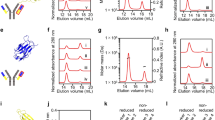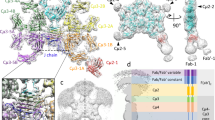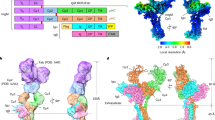Abstract
The structure of a mutant immunoglobulin-binding B1 domain of streptococcal protein G (GB1), which comprises five conservative changes in hydrophobic core residues, was determined by NMR spectroscopy and X-ray crystallography. The oligomeric state and quaternary structure of the mutant protein are drastically changed from the wild type protein. The mutant structure consists of a symmetric tetramer, with intermolecular strand exchange involving all four units. Four of the five secondary structure elements present in the monomeric wild type GB1 structure are retained in the tetrameric structure, although their intra- and intermolecular interactions are altered. Our results demonstrate that through the acquisition of a moderate number of pivotal point mutations, proteins such as GB1 are able to undergo drastic structural changes, overcoming reduced stability of the monomeric unit by multimerization. The present structure is an illustrative example of how proteins exploit the breadth of conformational space.
This is a preview of subscription content, access via your institution
Access options
Subscribe to this journal
Receive 12 print issues and online access
$189.00 per year
only $15.75 per issue
Buy this article
- Purchase on Springer Link
- Instant access to full article PDF
Prices may be subject to local taxes which are calculated during checkout





Similar content being viewed by others
References
Gronenborn, A.M. et al. A novel, highly stable fold of the immunoglobulin binding domain of streptococcal protein G. Science 253, 657–661 (1991).
Gallagher, T., Alexander, P., Bryan, P. & Gilliland, G.L. Two crystal structures of the β1 immunoglobulin-binding domain of streptococcal protein G and comparison with NMR. Biochemistry 33, 4721–4729 (1994).
Tcherkasskaya, O., Knutson, J.R., Bowley, S.A., Frank, M.K. & Gronenborn, A.M. Nanosecond dynamics of the single tryptophan reveals multi-state equilibrium unfolding of protein GB1. Biochemistry 39, 11216–11226 (2000).
Malakauskas, S.M. & Mayo, S.L. Design, structure and stability of a hyperthermophilic protein variant. Nature Struct. Biol. 5, 470–475 (1998).
Gronenborn, A.M., Frank, M.K. & Clore, G.M. Core mutants of the immunoglobulin binding domain of streptococcal protein G: stability and structural integrity. FEBS Lett. 398, 312–316 (1996).
Achari, A. et al. 1.67 Å X-ray structure of the B2 immunoglobulin-binding domain of streptococcal protein G and comparison to the NMR structure of the B1 domain. Biochemistry 31, 10449–10457 (1992).
Gronenborn, A.M. & Clore, G.M. Rapid screening for structural integrity of expressed proteins by heteronuclear NMR spectroscopy. Protein Sci. 5, 174–177 (1996).
Clore, G.M & Gronenborn, A.M. Structures of larger proteins in solution: three- and four-dimensional heteronuclear NMR spectroscopy. Science 252, 1390–1399 (1991).
Bax, A. & Grzesiek, S. Methodological advances in protein NMR. Acc. Chem. Res. 26, 131–138 (1993).
Clore, G.M. & Gronenborn, A.M. Determining structures of larger proteins and protein complexes by NMR. Trends Biotechnol. 16 22–34 (1998).
Omichinski, J.G. et al. NMR structure of a specific DNA complex of Zn-containing DNA binding domain of GATA-1. Science 261, 438–446 (1993).
Annila, A., Aittio, H., Thulin, E. & Drakenberg, T. Recognition of protein folds via dipolar couplings. J. Biol NMR 14, 223–230 (1999).
Barrientos, L.G. et al. 1H, 13C, 15N resonance assignments and fold verification of a circular permuted variant of the potent HIV-inactivating protein cyanovirin-N. J. Biomol. NMR 19, 289–290 (2001).
Cornilescu, G., Marquardt, J.L., Ottiger, M. & Bax, A. Validation of protein structure from anisotropic carbonyl chemical shifts in a dilute liquid crystalline phase. J. Am. Chem. Soc. 120, 6836–6837 (1998).
Nilges, M., Clore, G.M. & Gronenborn, A.M. Determination of three-dimensional structures of proteins from interproton distance data by hybrid distance geometry-dynamical simulated annealing calculations. FEBS Lett. 229, 317–324 (1988).
Brünger, A.T. et al. Crystallography and NMR system (CNS): a new software system for macromolecular structure determination. Acta Crystallogr. D 54, 905–921 (1998).
Hendrickson, W.A. Determination of macromolecular structures from anomalous diffraction of synchrotron radiation. Science 254, 51–58 (1991).
Kuhlman, B., O'Neill, J.W., Kim, D.E., Zhang, K.Y.J. & Baker, D. Conversion of monomeric protein L to an obligate dimer by computational protein design. Proc. Natl. Acad. Sci. USA 98, 10687–10691 (2001).
Bennett, M.J., Choe, S. & Eisenberg, D. Domain swapping — entangling alliances between proteins. Proc. Natl. Acad. Sci. USA 91, 3127–3131 (1994).
Delaglio, F. et al. NMRPipe: a multidimensional spectral processing system based on UNIX pipes. J. Biomol. NMR 6, 277–293 (1995).
Garrett, D.S., Powers, R., Gronenborn, A.M. & Clore, G.M. A common sense approach to peak picking in two-, three- and four-dimensional spectra using automatic computer analysis of contour diagrams. J. Magn. Reson. 94, 214–220 (1991).
Cornilescu, G., Delaglio, F. & Bax, A. Protein backbone angle restraints from searching a database for protein chemical shift and sequence homology. J. Biomol. NMR 13, 289–302 (1999).
Warren, J.J. & Moore, P.B. A maximum likelihood method for determining Da and R for sets of dipolar coupling data. J. Magn. Reson. 149, 271–275 (2001).
Nilges, M. A calculational strategy for the structure determination of symmetric dimers by 1H NMR. Proteins Struct. Funct. Genet. 17, 297–309 (1993).
O'Donoghue, S.I., King, G.F. & Nilges, M. Calculation of symmetric multimer structures from NMR data using a priori knowledge of the monomer structure, co-monomer restraints, and interface mapping: the case of leucine zippers. J. Biomol. NMR 8, 193–206 (1996).
Ramachandran, G.N., Ramakrishnan, C. & Sasisekharan, V. Stereochemistry of polypeptide chain configurations. J. Mol. Biol. 7, 95–99 (1963).
Laskowski, R.A., MacArthur, M.W., Moss, D.S. & Thornton, J.W. PROCHECK: a program to check the stereochemical quality of protein structures. J. Appl. Crystallogr. 26, 283–291 (1993).
Koradi, R., Billeter, M. & Wüthrich, K. A program for display and analysis of macromolecular structures. J. Mol. Graph. 14, 51–55 (1996).
Carson, M. RIBBONS 2.0. J. Appl. Crystallogr. 24, 958–961 (1991).
Jancarik, J. & Kim, S.-H. Sparse matrix sampling: a screening method for crystallization of proteins. J. Appl. Crystallogr. 24, 409–411 (1991).
Otwinowski, Z. & Minor, W. Processing of X-ray diffraction data collected in oscillation mode. Methods Enzymol. 276, 307–326 (1997).
Sheldrick, G.M. in Direct Methods for Solving Macromolecular Structures (ed. Fortier, S.) 401–411 (Kluwer Academic Publications, Dordrecht; 1998).
Ramakrishnan, V., Finch, J.T., Graziano, V., Lee, P.L. & Sweet, R.M. Crystal structure of globular domain of histone H5 and its implications for nucleosome binding. Nature 362, 219–223 (1993).
Wang, B.-C. Resolution of phase ambiguity in macromolecular crystallography. Methods Enzymol. 115, 90–112 (1985).
Jones, T.A., Zou, J.-Y., Cowan, S.W. & Kjeldgaard, M. Improved methods for building protein models in electron density maps and the location of errors in these models. Acta Crystallogr. A 47, 110–119 (1991).
Furey, W. & Swaminathan, S. PHASES-95: A program package for processing and analyzing diffraction data from macromolecules. Methods Enzymol. 277, 590–620 (1997).
Brünger, A.T. X-PLOR: a system for X-ray crystallography and NMR (Yale University Press, New Haven; 1993).
Navaza, J. & Saludjian, P. AMoRe: an automated molecular replacement program package. Methods Enzymol. 276, 581–594 (1997).
Brünger, A.T. Free R value: a novel statistical quantity for assessing the accuracy of crystal structures. Nature 355, 472–475 (1992).
Tronrud, D.E. Knowledge-based B-factor restraints for the refinement of proteins. J. Appl. Crystallogr. 29, 100–104 (1996).
Brooks, B.R. et al. CHARMM: a program for macromolecular energy, minimization, and dynamics calculations. J. Comp. Chem. 4, 187–217 (1983).
Acknowledgements
We thank D. Garrett and F. Delaglio for software and R. Tschudin for technical support; L. Pannell for mass spectrometry; P. Wingfield for analytical ultracentrifugation; I. Nesheiwat and J.M. Louis for expert help with the HS#124 mutants; A.B. Hickman and Z. Dauter for help with crystallization, data collection and SHELXD32; and P. Koehl and J. M. Louis for numerous useful discussions. This work was supported in part by the Intramural AIDS Targeted Antiviral Program of the Office of the Director of the National Institutes of Health to A.M.G.
Author information
Authors and Affiliations
Corresponding author
Ethics declarations
Competing interests
The authors declare no competing financial interests.
Rights and permissions
About this article
Cite this article
Kirsten Frank, M., Dyda, F., Dobrodumov, A. et al. Core mutations switch monomeric protein GB1 into an intertwined tetramer. Nat Struct Mol Biol 9, 877–885 (2002). https://doi.org/10.1038/nsb854
Received:
Accepted:
Published:
Issue Date:
DOI: https://doi.org/10.1038/nsb854



